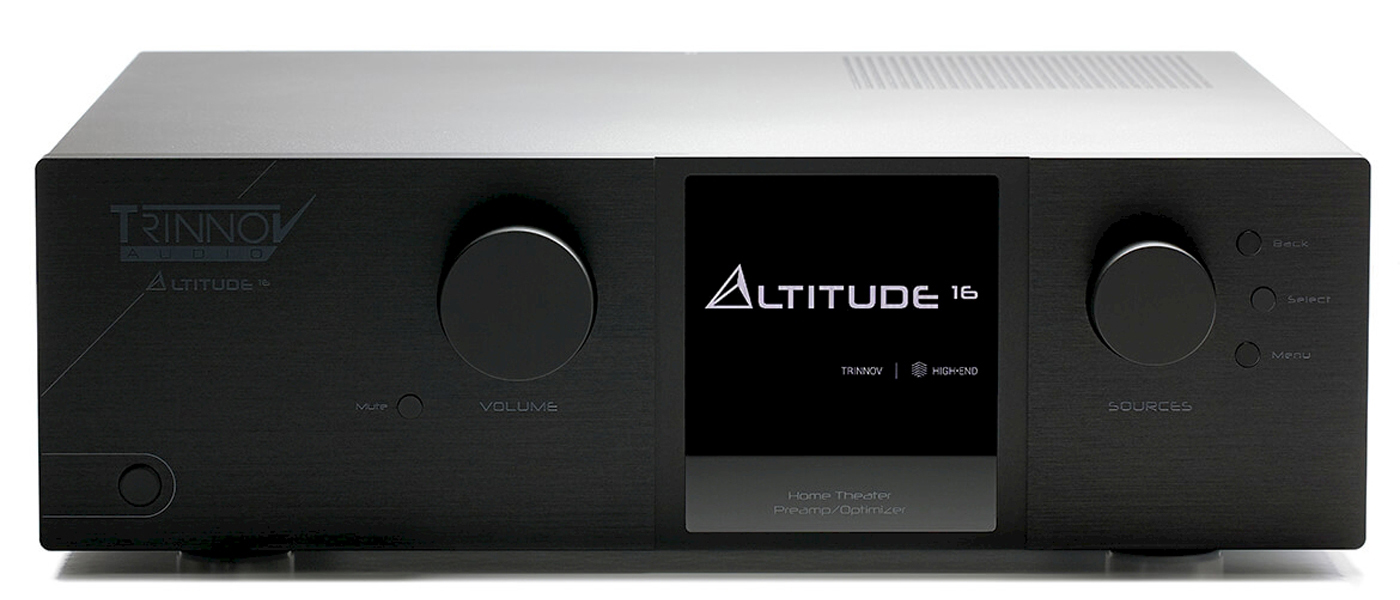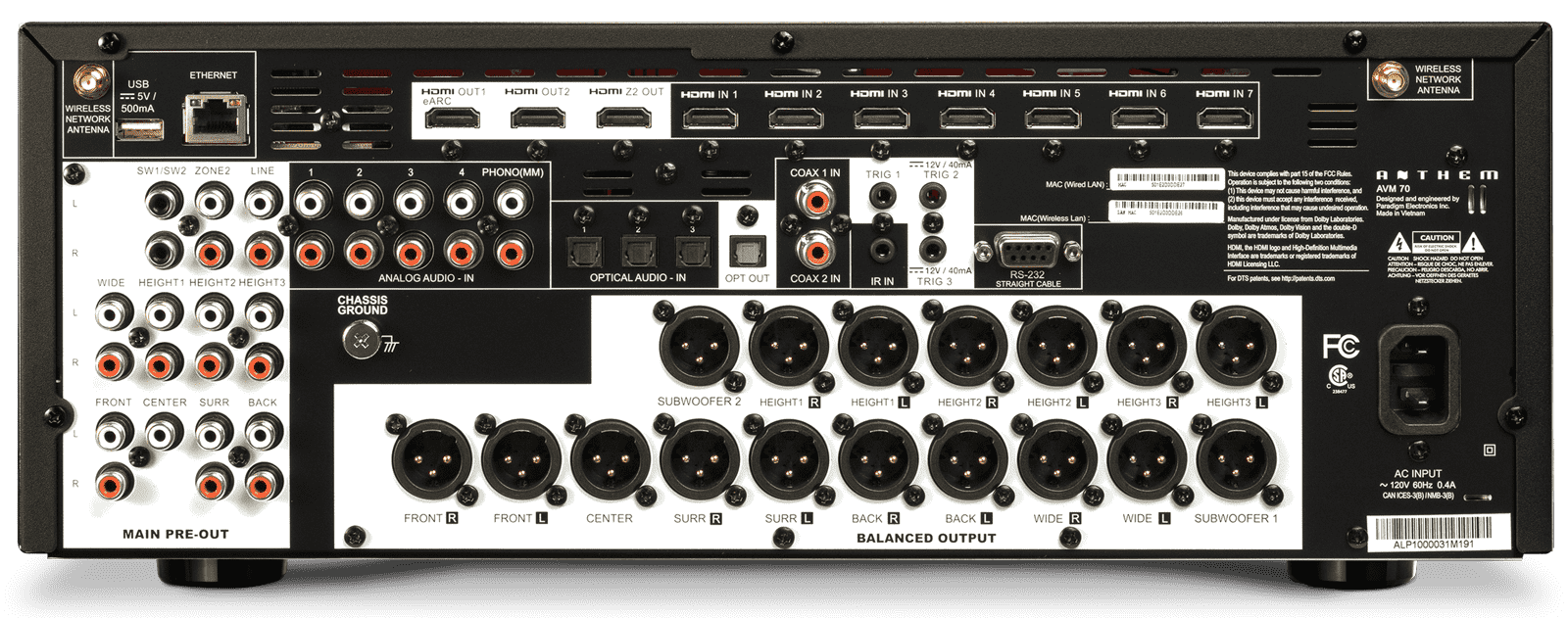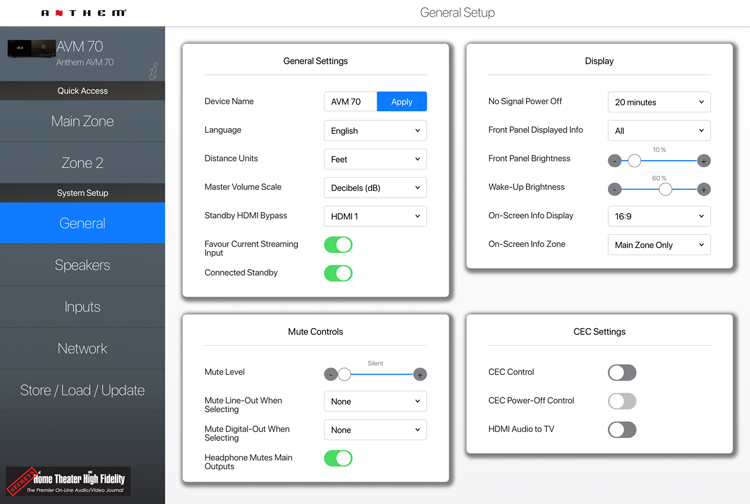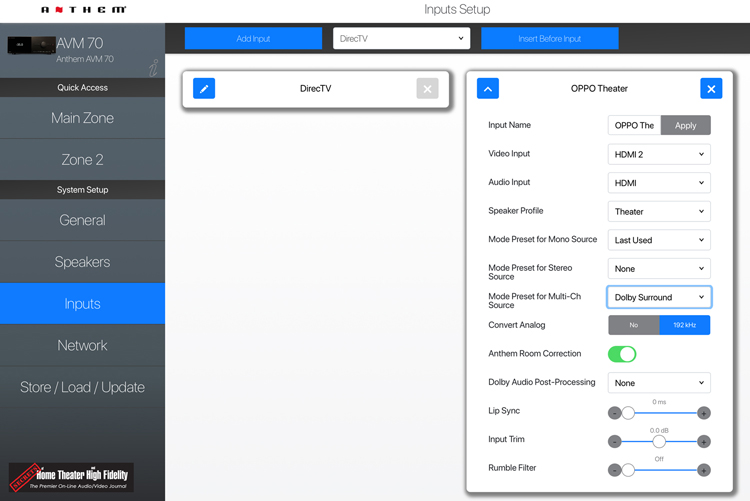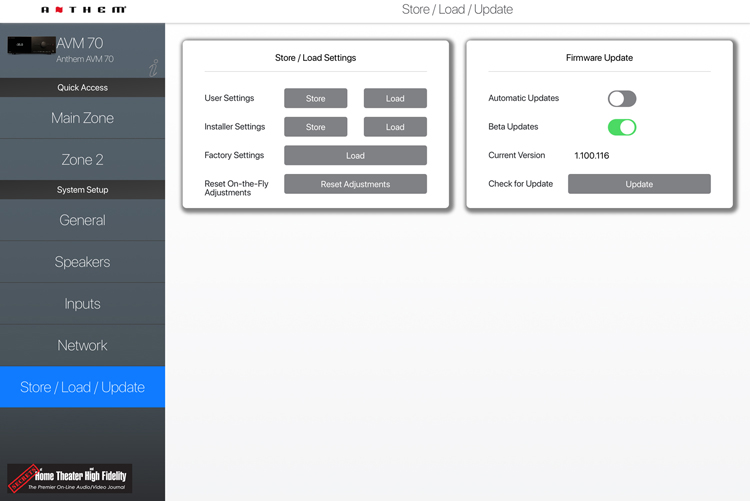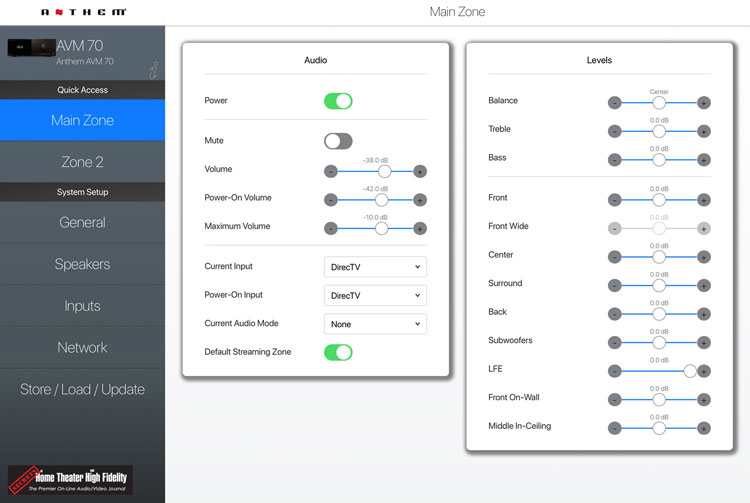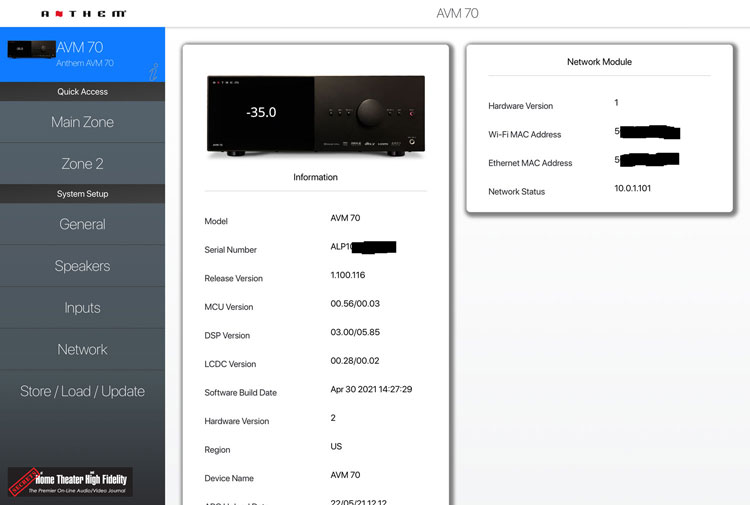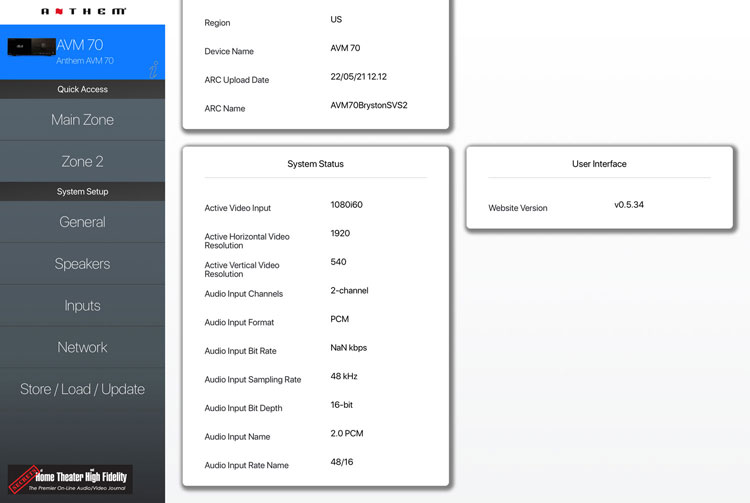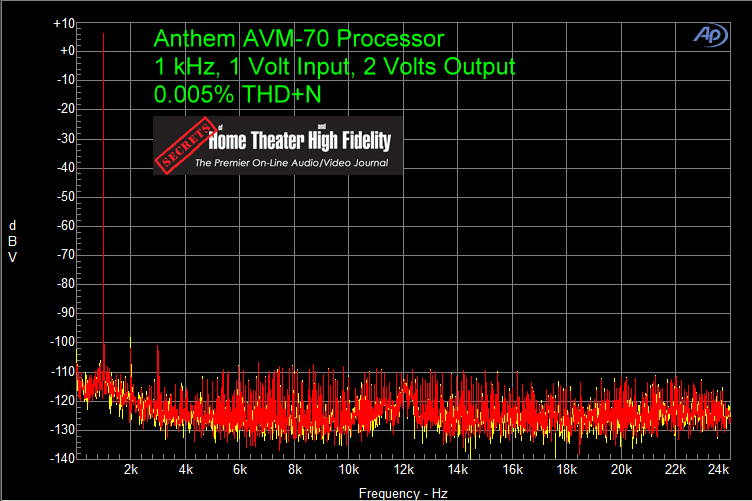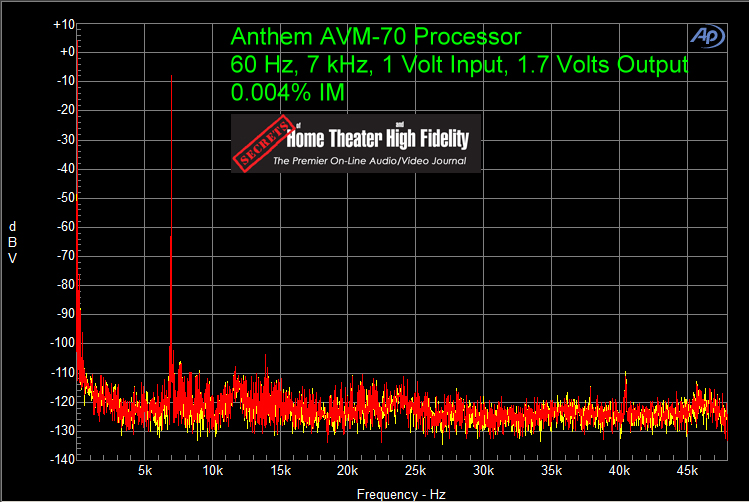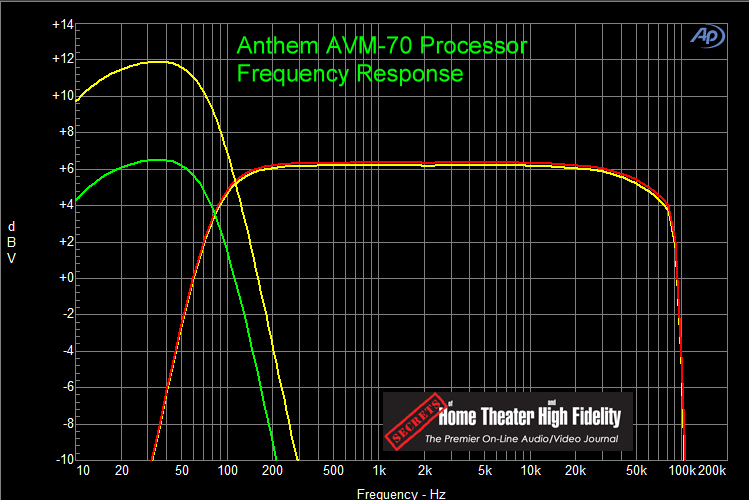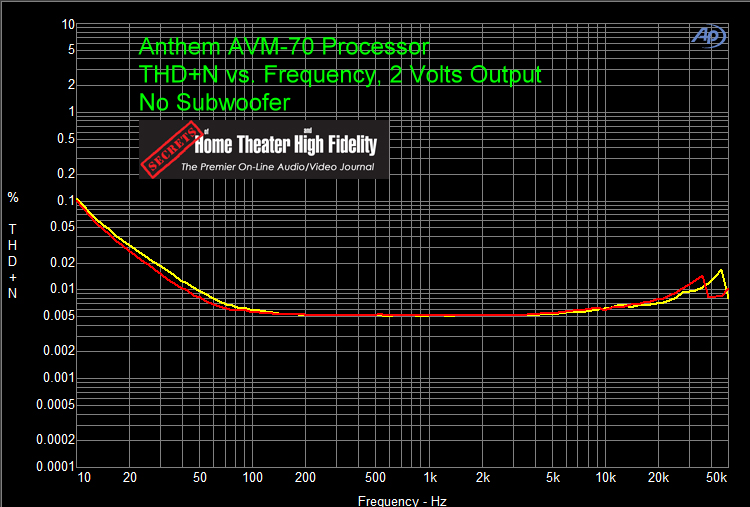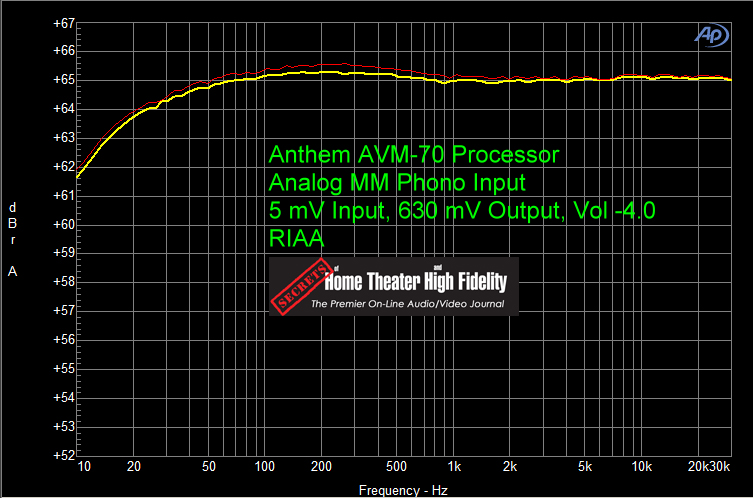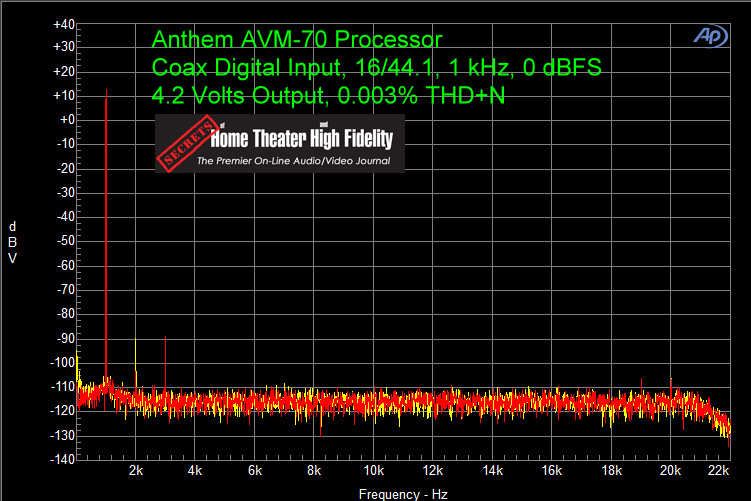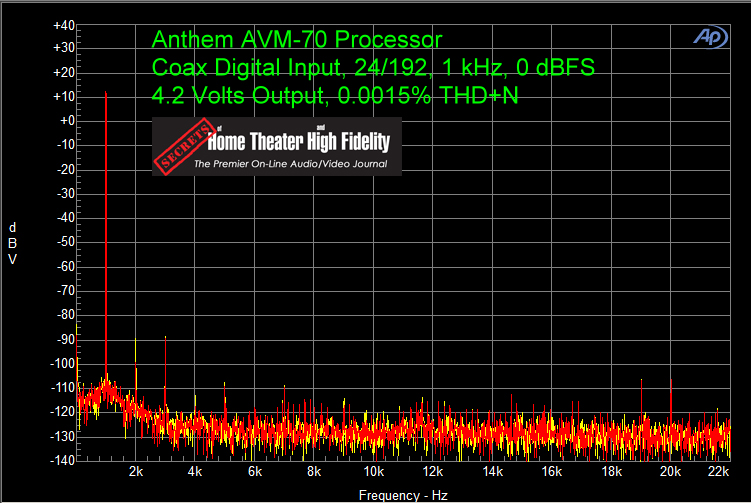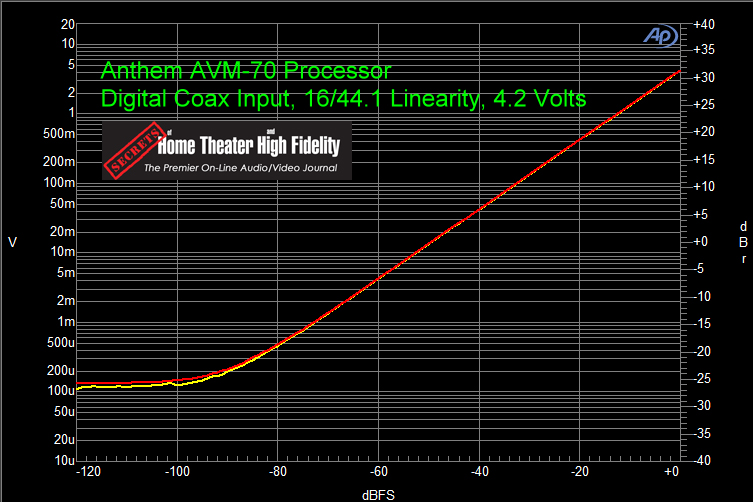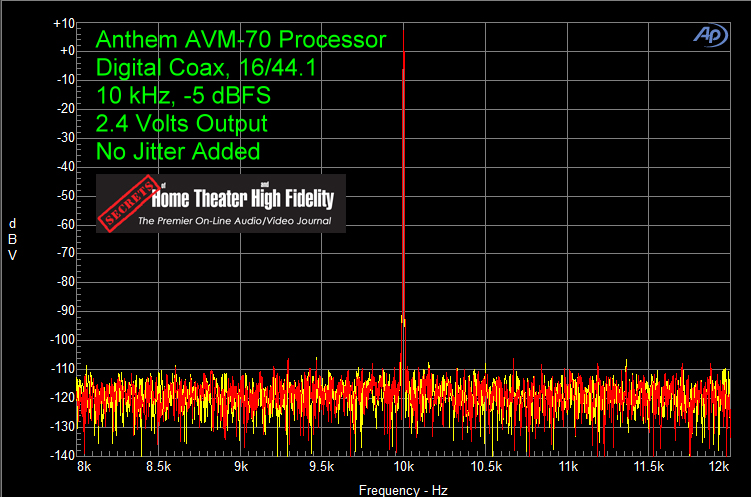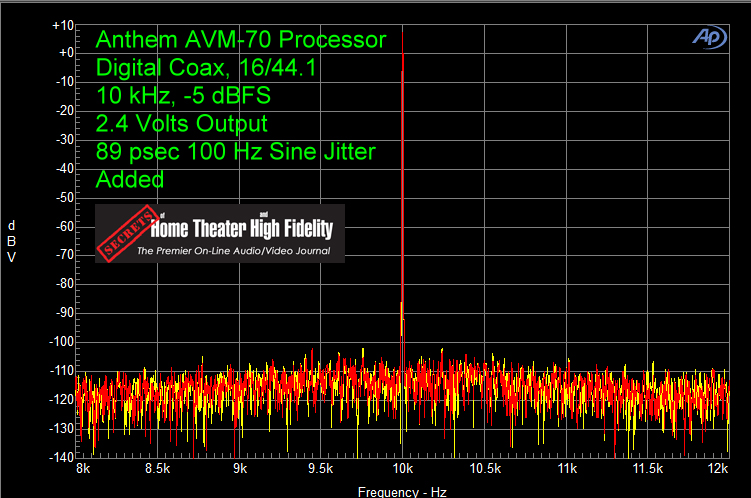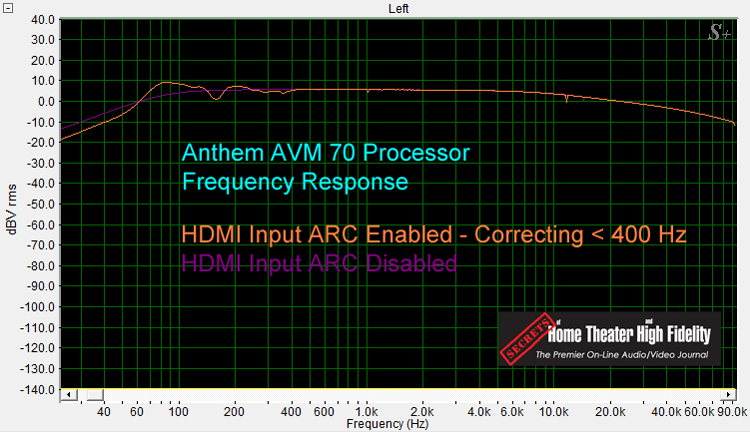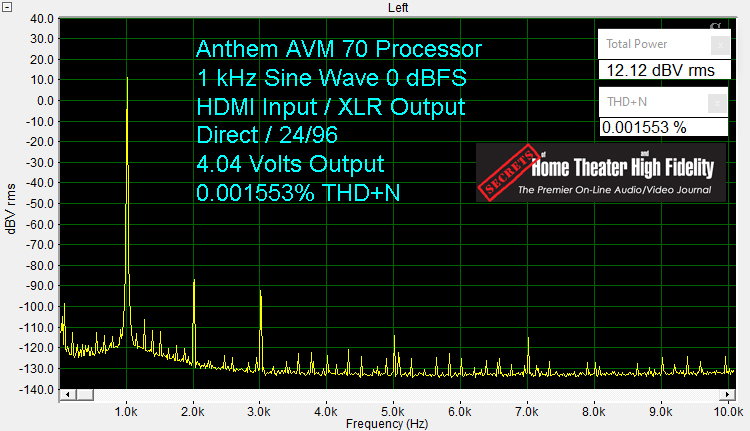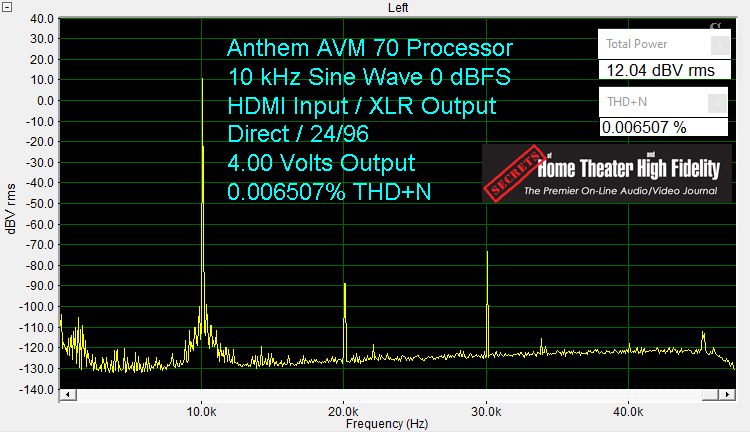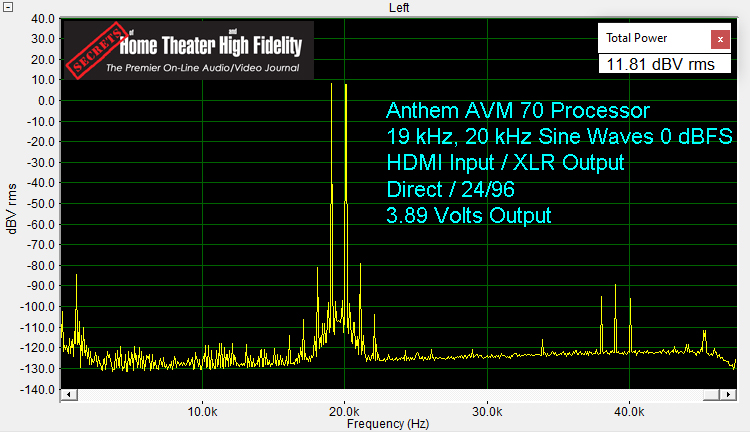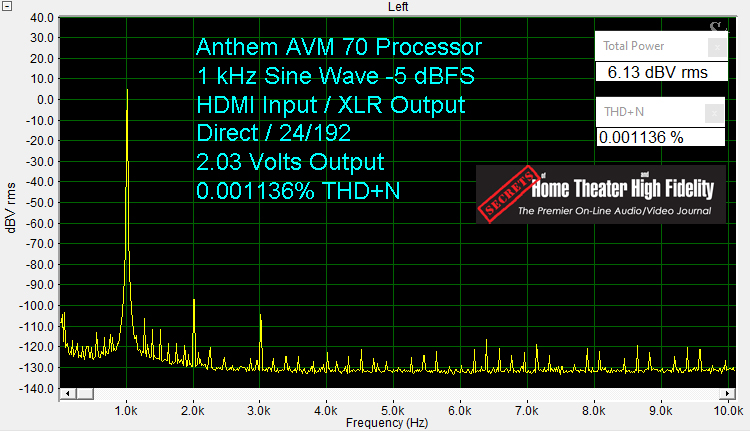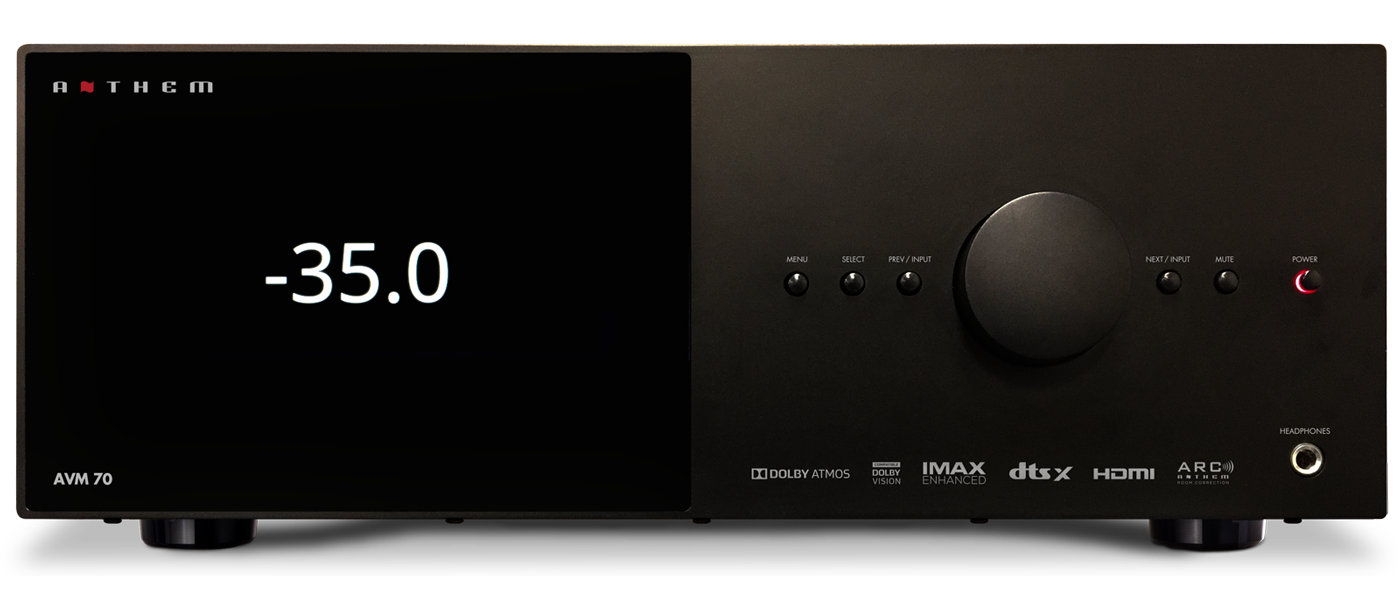
With updated connectivity for Apple AirPlay 2, Google Chromecast, and future support for Spotify Connect and Roon Ready, the AVM 70 can easily connect you to the latest streaming content. Add in Anthem’s ARC Genesis Room Correction software, an updated web interface for easy setup and control, and future upgradability to HDMI 2.1 with 8K video support, and you’ve got a very capable processor for your home theater or media room.
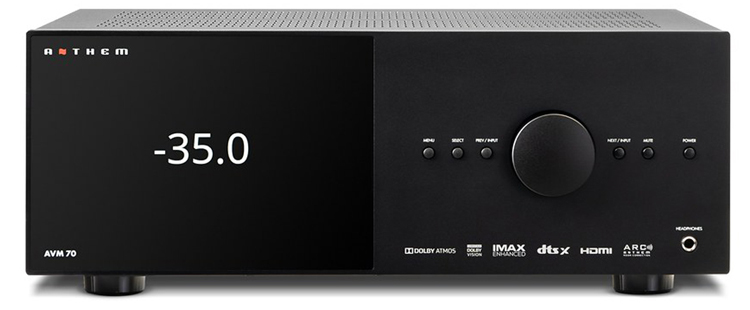
The AVM 70 continues the Anthem tradition of outstanding A/V preamps/processors. The Anthem AVM 70 is a next-generation 15.2-channel preamplifier-processor. The product styling has been updated and now shares its looks with Anthem’s STR series products. The AVM 70 processes both the Dolby Atmos and DTS:X object-based audio formats, and now includes DTS:X Pro, a format that supports up to 32 connected speakers. Anthem has upgraded their ARC Genesis Room Correction software to support up to 15.2 channel configurations on the AVM 70, and they have updated the included ARC kit with a more accurate calibration microphone.
The AVM 70 supports HDMI 2.0b and all the expected video features like passthrough of 4K/60Hz Ultra HD signals at up to 18.2 Gbps, HDCP 2.2, 4:4:4 color subsampling, wide color gamut (BT.2020), Dolby Vision, HDR10, and Hybrid Log-Gamma. Anthem also added support for eARC (enhanced Audio Return Channel) if you have a compatible HDTV. The AVM 70 now includes the licensed IMAX Enhanced technology, which combines IMAX digitally re-mastered 4K HDR content and enhanced DTS:X audio, to deliver IMAX Enhanced content in your home theater. This feature requires that you have an IMAX Enhanced certified display or projector.
Anthem also updated connectivity on the AVM 70 with support for Apple AirPlay 2, Google Chromecast, and the latest Bluetooth. Anthem will be adding support for both Spotify Connect and Roon Ready in the future. Anthem will be offering a future paid hardware upgrade to support HDMI 2.1 and 8K video. Finally, the AVM 70 now comes with a web-based user interface for both configuration and control.
Anthem AVM 70 Preamplifier-Processor
- Supports configurations up to 15.2 channels and adds DTS:X Pro and IMAX Enhanced processing.
- The Anthem ARC Genesis Room Correction software has been updated to support 15.2 channel configurations and a more accurate calibration microphone is included in the ARC kit.
- The legacy setup interface is no longer available via your connected HDTV but is replaced with a new browser-based interface for setup and control.
- Supports Apple AirPlay 2, Google Chromecast, and the latest Bluetooth.
- Spotify Connect and Roon Ready will be coming in future updates.
- The AVM 70 will be upgradeable to HDMI 2.1 with support for 8K video via a paid hardware upgrade.
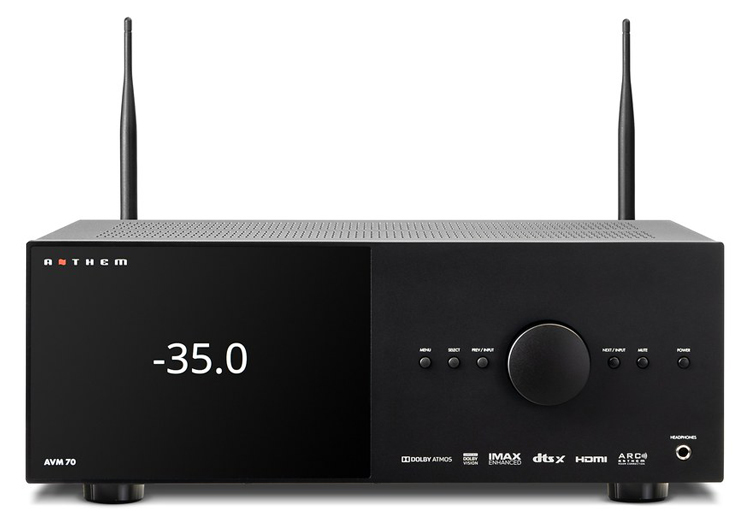
The Anthem AVM series preamplifier-processor (surround processor) has a long tradition in the A/V industry. We’ve been covering their evolution here at Secrets for the last twenty years. The last model I reviewed was the Anthem AVM 60, the predecessor of the AVM 70 which is the subject of this review.
Processor and receiver changes are often driven by changes in HDMI technology and surround format changes, and that is once again the case here. Anthem used to offer hardware upgrades to their AVM line, but that practice stopped when the older AVM 50 product architecture was retired. With the introduction of the AVM 70 and the updated MRX series receivers, Anthem is now dipping its toes back in the upgrade world by offering a future paid hardware upgrade to support HDMI 2.1 and 8K video. Details on the upgrade process and costs will be announced in the future. Let’s take a detailed look at the AVM 70 and see what’s changed.
Design:
15.2-channel Preamp / Processor
Dolby® and DTS® Surround Sound Processing:
Dolby Atmos, Dolby Surround, DTS:X, DTS:X Pro, DTS Virtual:X, DTS Neural:X
IMAX Enhanced Technology:
supports IMAX digitally remastered 4K HDR content and DTS:X audio
Room Correction:
Anthem ARC Genesis with a calibrated microphone and stand included
Video:
4K/60Hz Pass-through and switching, 4:4:4 color subsampling at 4K60 (18.2 Gbps), BT.2020 (wide color gamut), HDR (high dynamic range): Dolby Vision, HDR10, HLG (Hybrid-Log Gamma)
Streaming Support:
Apple AirPlay 2, Google Chromecast, Bluetooth; Future options: Spotify Connect and Roon Ready
Number of Zones:
2
Connections
HDMI 2.0b:
7 In, 3 out (main, parallel, Zone 2); main HDMI out supports ARC (audio return channel) and eARC (enhanced audio return channel)
Digital Audio Inputs:
3 Optical and 2 Coaxial
Analog Audio Inputs:
4 RCA
Phono Input:
1 MM
Analog Audio Outputs:
1 stereo pair for line out, 1 stereo pair for Zone 2
Pre-Outs:
15.2 Channel (RCA and XLR), including 2 discrete subwoofers
USB Ports:
1 rear for factory service only
Network:
Ethernet Port for Wired Network Connection, built-in Wi-Fi
Control:
RS-232C, Remote IR (1 in), 12 Volt-trigger (3 out), IP Control
Headphone jack:
1/4″ front panel output
General Features
Web User Interface:
Browser-based
Accessories:
Remote Control
Dimension:
6.5″ H x 17″ W x 14.5″ D (height does not include Wi-Fi antennas)
Weight:
22.1 Pounds
MSRP:
$3,499.99 USD
Website:
Company:
SECRETS Tags:
Anthem, Anthem AVM 70, Surround Processor, Preamplifier, Dolby Atmos, Dolby Surround, DTS:X, DTS:X Pro, Dolby Vision, IMAX Enhanced, ARC Genesis, Anthem Room Correction, Processor Review 2021

Anthem has updated the looks of the AVM 70 borrowing heavily from the design aesthetics of the STR series products. The entire product lineup including the MCA Gen 2 amplifiers and the MRX series receivers, all have a modern minimalist design, with a black panel on the left and a flat aluminum faceplate to the right. The aluminum faceplate on the STR series is sculpted, but at a quick glance, you might not spot the difference when looking at the AVM 70. Controls are minimal, with only the menu and input selection/navigation, mute, and power buttons, all centered around the volume control. A ¼” headphone jack is included.
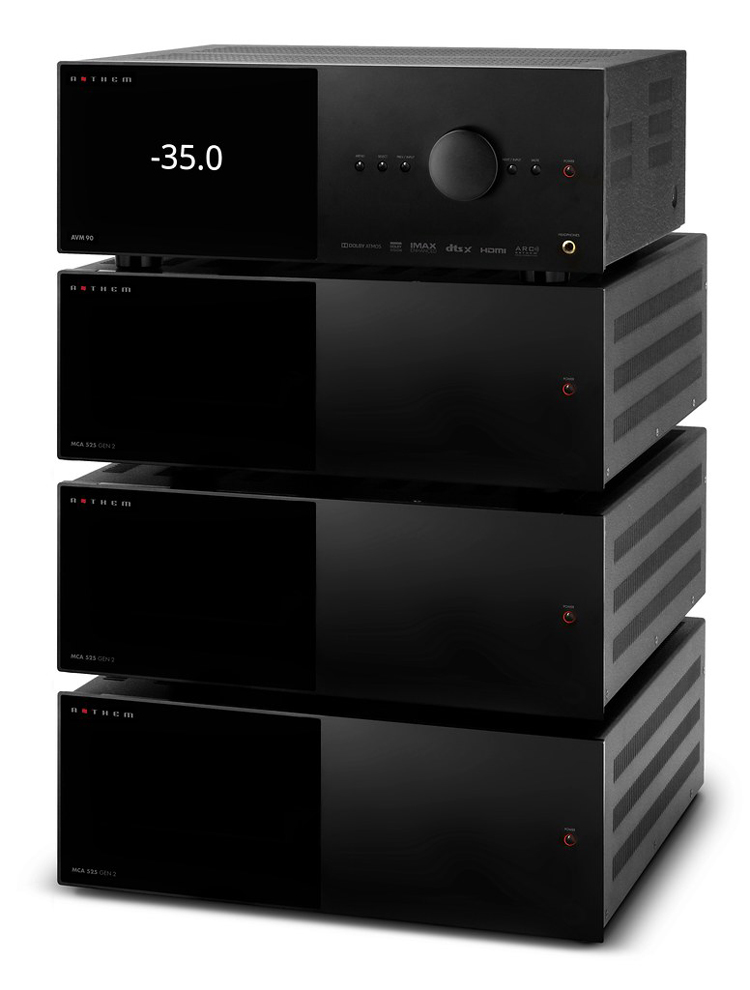
The rear panel has been rearranged and now has 17 balanced XLR outputs to support 15 speakers and two independent subwoofers.
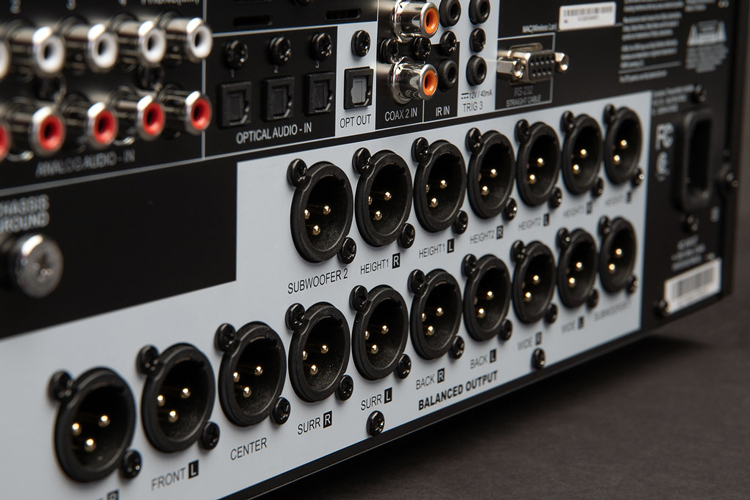
The AVM 70 no longer has a front HDMI input, so the rear panel now supports 7 HDMI inputs, two parallel HDMI outputs, and an HDMI output for Zone 2. The HDMI ports are HDMI 2.0b-compliant and they all support HDCP 2.2. The AVM 70 supports HDMI video switching and video pass-through at 4K/60Hz resolution, BT. 2020 wide color gamut, 4:4:4 Subsampling at 4K60 (18.2 Gbps), as well as the HDR (high dynamic range) formats Dolby Vision, HDR10, and HLG (Hybrid-Log Gamma).
Anthem includes 17 unbalanced RCA pre-out connections, four pairs of stereo analog inputs, two pairs of stereo analog outputs (one for line out and the other for zone 2), three optical inputs and one optical output, and two coaxial digital inputs. The AVM 70 adds a dedicated phono input that is designed for use with a moving-magnet (MM) cartridge.
For networking, the AVM 70 includes both an Ethernet jack as well as built-in Wi-Fi support with two antennas. Anthem has refreshed its streaming support, dropping DTS Play-Fi, and adding Apple AirPlay 2, Google Chromecast, and Bluetooth. Future streaming options will include Spotify Connect and Roon Ready.
For control, Anthem includes IP control with support for major third-party control systems, an RS-232 jack, one IR input, and finally three 12-Volt trigger outputs that can be used to turn on external amplifiers. The AVM 60 only offered one 12-volt trigger, so this change is much appreciated when you consider the number of amplifiers that could be needed with the AVM 70.
With the AVM 70, Anthem drops the FM tuner and MHL (Mobile High-Definition Link), and while there is a USB port on the rear panel, it is only used as a service port by Anthem.
The AVM 70 comes with the same backlit remote that is standard with the MRX receiver line.
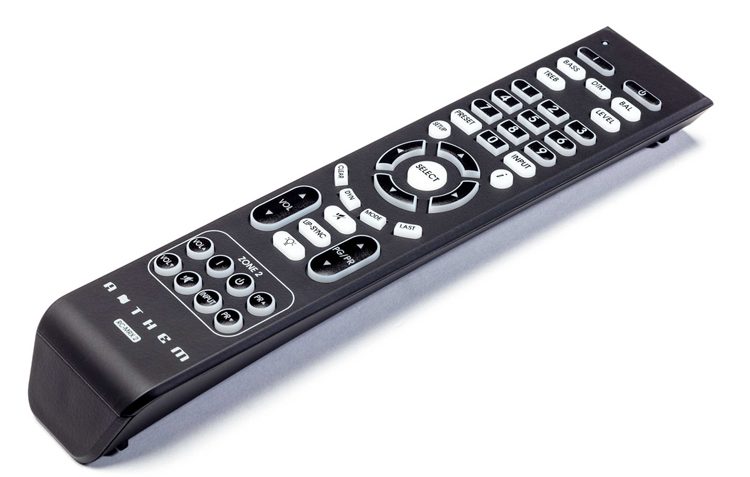
From a technology perspective, the AVM 70 supports Dolby Atmos, DTS:X, DTS:X Pro, and speaker configurations up to 9.2.6 with three pairs of height channels. The latest Dolby Surround and DTS Neural:X upmixers are included to synthesize an immersive 3D surround experience from a stereo or multichannel soundtrack.
While it was only a few years ago that having at least one pair of height speakers in the listening room was the gateway to enjoying 3D surround formats like Dolby Atmos and DTS:X, the norm today is to support configurations up to 15.2 channels. This means that the AVM 70 can support up to three pairs of height speakers.
To get started with setting up the AVM 70, I connected my amplifiers, components, and HDTV to the AVM 70. Powering up the AVM 70 brings to life a 4” TFT display that at first looks a bit small against the full height of the AVM 70. The startup sequence looks identical to that of the Anthem STR Preamp and the height of the AVM 70 makes it look more like the STR Power Amp only without the larger TFT display.
I pressed the menu button and expected to see the typical Anthem setup menu on my HDTV. Instead, I just saw a crisp two-line display that read “Main Menu Speaker Setup”. As I scrolled through the menus, I quickly realized that it was time to embrace the reality that the old menu system would no longer be seen on my HDTV. So, what happened? Anthem still offers the legacy menu system, but it can only be seen on the 4” TFT display on the front of the AVM 70. The alternative and preferred option is to connect the AVM 70 to your home network and then use the new browser-based interface. It may sound complicated at first, but once you start using it you will soon forget about those classic menus.
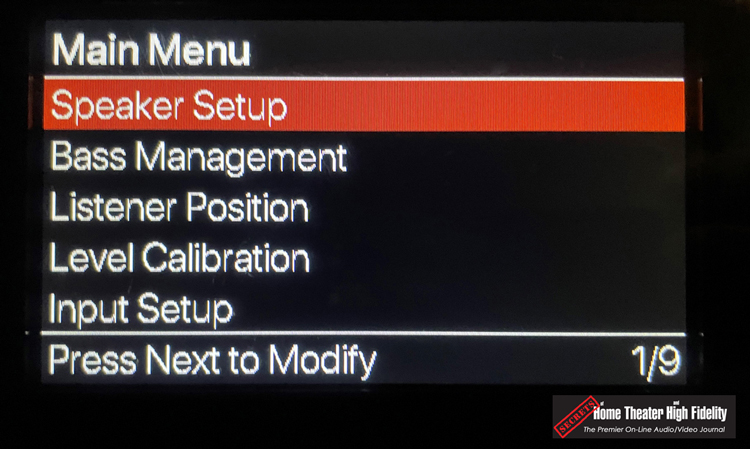
I connected the AVM 70 to my network, opened a browser tab on my iPad, and entered the IP address for the AVM 70. I was greeted with a lovely web page that offers complete access for configuring the AVM 70. The management web interface is organized around a Quick Access section that includes the Main Zone and Zone 2. System Setup is then organized into sections to configure the processor. Let’s take a quick tour.
General Setup offers options for naming your processor, selecting language, and important things like Standby HDMI bypass, mute controls, and options for Display and CEC control.
Speakers Setup allows for the configuration of up to three sets of height speakers, and then options for up to four speaker profiles. These profiles can be configured with the Anthem ARC Genesis software.
Inputs Setup lets you configure up to 30 virtual inputs. The processor comes with a default input configuration, and those inputs can be renamed, configured, and deleted as desired. There is no option to reorder the inputs on the web interface, but new inputs can be added at the end of the list or before any selected input which helps with organization.
Clicking the pencil icon on an input brings up all the familiar options, including options for speaker profile and surround mode presets based on the source type. The best thing about the virtual inputs is that multiple inputs can be configured to the same HDMI input without restriction. The only confusing thing in the input setup interface is the blue X in the upper corner of each input. While I thought they were intended to close the editing menu at first, they are really used to delete unwanted inputs. A nice prompt appears if selected, so there’s not much chance of any accidental input deletion. I would like to see Anthem change this to a different icon or color, like a trash can or a red X, to make the purpose clear.
Network Setup offers options for configuring the Ethernet and Wi-Fi configurations, provides a handy IP Status display, and includes the Trigger configuration options.
Store / Load / Update allows for saving settings and for resetting the AVM 70 back to factory defaults. This page also includes options to update the firmware on the AVM 70 as well as enable the option to receive beta updates from Anthem.
After configuring the inputs, I jumped over to my Windows 10 laptop and updated the ARC Genesis software with the latest release. I then ran ARC Genesis which walked me through selecting the configuration for my height channels and then ran measurements against each of my speakers from five different positions. The ARC Genesis setup process was largely unchanged with the AVM 70 except for two notable differences. The first is that there is now an option to select a third set of height speakers. The second is that the microphone provided in the ARC kit has changed and should still be oriented vertically, but now with the small black dot on the front of the microphone facing the front of the listening room.
I asked Anthem what was different about the new ARC microphone, and they responded as follows:
“The new microphone is a MEMS style microphone which offers a better consistency of measurements across microphones so there is no longer a need for a specific calibration file. The label for the front of the microphone is to help the microphone capture high frequencies accurately (above 5 kHz)”
I created three profiles for my speaker configuration, one for a 7.1.4 theater, one for stereo, and another for stereo with a subwoofer. In terms of room correction, I typically just correct the low-frequency response since I’ve found that gives me the best results in my room. The ARC Genesis software quickly uploaded the configuration into the AVM 70. The only thing left for me to do was to confirm the distances for the speakers in the AVM 70 Speakers Setup menus. This is still a wish list item that I would like to see Anthem include in a future software release. At a minimum, it would be great if the speaker distances could be configured in the ARC Genesis software and then transferred once to the processor.
In my listening environment, I used a 7.1.4 GoldenEar Technology Triton Reference system with a pair of Triton Reference front speakers with powered subwoofers, a GoldenEar SuperCenter X center channel, a pair of GoldenEar Invisa MPX in-walls as surround speakers, two pair of GoldenEar Invisa HTR 7000 as top-middle height and rear surrounds, and a pair of GoldenEar Aon 2 speakers for front height speakers. I used a pair of Bryston 7B3 Cubed Series mono-blocks for my main channels, a five-channel Bryston 9B3 Cubed Series amp for my surround and center channels, and a Rotel RMB-1095 to power the height channels. For the .1 subwoofer channel, I used an SVS SB16-Ultra subwoofer. I used an Oppo UDP-205 4K Ultra HD Blu-ray player and an Apple TV 4K (2017 model) as my primary source devices.
I created three input profiles on the AVM 70 for my Oppo UDP-205, so I could easily switch between the multiple speaker profiles that I had created during setup. The great thing about having multiple inputs is that you can really experiment with different options and slowly adjust the system until you’ve dialed in what sounds and works best for you. The new web interface also made it simple to change input configurations on the fly.
It has been almost four years since I reviewed the previous Anthem AVM 60 processor, and it is amazing how much more 4K video and high-resolution music content has now become available through streaming services. While watching a 4K UHD Blu-ray would still be my top pick for maximizing the home theater experience, the AVM 70 proved very capable at delivering an outstanding listening experience regardless of my content source.
I had the opportunity to sample a variety of music and films while auditioning the Anthem AVM 70 and the Anthem lived up to my expectations, bringing both music and movies to life. In my system, the AVM 70 soundstage was expansive and richly detailed, and dialog was well placed and clear. Anthem Room Correction blended my SVS SB16-Ultra subwoofer into the system and did an excellent job managing the bass response in my room. The AVM 70 handled movie scores with ease, from the most dramatic special effects to the quietest moments, and everything in-between. Music was equally enjoyable with many listening sessions extending for hours of enjoyment.
The following are some of the highlights from my listening experience with the AVM 70.

Nora Jones,” … ‘Til We Meet Again – Live”, Blue Note Records, 24/96 FLAC via Roon and Qobuz
In the recently released Nora Jones album which offers a collection of live tour recordings, the first track “Cold, Cold Heart” captured my attention. The first soulful notes drifted into my room and quickly evolved into a richly textured jazz listening experience. While I have heard this song countless times before, on other recordings, the Anthem immediately drew me into the magic of a live performance. I was delighted to hear how good a fresh version of a familiar song could sound. I went on to listen to another familiar piece, “Don’t Know Why.” Nora’s vocals partnered with the gorgeous piano were beautifully placed in the soundstage and the emotion of her voice was very present. The shimmering sound of the cymbals and the powerful yet balanced feel of the bass added to that live performance feel.

Steve Martin and the Steep Canyon Rangers, “Me and Paul Revere”, New Rounder, 16/44 FLAC via Roon and Qobuz
For a completely different genre of music, I opted for a piece of bluegrass and put the Anthem to the test with some light-hearted music from Steve Martin and the Steep Canyon Rangers. If you’re wondering, yes, this is the same Steve Martin you know as the accomplished comedian, writer, and actor. Steve Martin is also an excellent musician and banjo player! Their song “Me and Paul Revere” is a unique take on the famous midnight ride, a narrative of that adventure told from the incredibly unique “first-horse” viewpoint of Revere’s borrowed mare Brown Beauty. The Anthem let the strings shine through and convey the urgency of the evening’s events as they unfolded. I was especially struck by the clarity of the words being quickly sung – each one with perfect diction despite there being a lot of words compressed into the telling of this classic tale. The Anthem revealed the male vocal harmonies and the blending of the various strings in this song. Each instrument was showcased individually and could be perceived individually while working together to produce a wonderful marriage of tones.

Squirrel Nut Zippers, “Hot”, Mammoth, 16/44 FLAC via Roon and Qobuz
The Anthem also produced a spectacular rendering of “Put a Lid on It” by the swinging jazz group “The Squirrel Nut Zippers.” I was interested to hear this song that highlights both female and male vocals as well as horns and percussion. There is a lot going on in this recording and the Anthem handled the layers beautifully. The Anthem bounced easily between the sparkling female and mellow male vocals, the featured baritone saxophone, the bright sound of the horns, and the tempo-keeping percussion that will surely make your feet move.

Rogue One: A Star Wars Story, 4K UHD Blu-ray, Dolby Atmos
“Rogue One: A Star Wars Story” was the first stand-alone movie in the Star Wars franchise and it tells the story of Jyn Erso and the band of rebels that steal the plans for the Death Star. This 4K UltraHD Blu-ray features a stunning 4K picture and an immersive Dolby Atmos soundtrack. From the terrifying first use of the Death Star to the battle on the beach and the final confrontation and collision of two Imperial Star Destroyers, this movie is highly recommended for showing off how much fun you can have in a home theater. The AVM 70 did a superb job with the Dolby Atmos soundtrack recreating all the action taking place around, behind, and above the listening position. ARC Genesis also kept my subwoofer well-controlled, enhancing the bass response and letting me feel the action. The volume on the Dolby Atmos track is mixed a little low on this disc, so don’t be afraid to turn up the volume.

Jurassic World Fallen Kingdom, 4K UHD Blu-ray, DTS:X, Dolby Vision
“Jurassic World Fallen Kingdom” continues the story after the dinosaurs destroyed the Jurassic World theme park. This 4K UltraHD Blu-Ray is another demo-worthy disc that features both Dolby Vision and DTS:X soundtracks. The AVM 70 recreated all the drama including an erupting volcano and a dinosaur stampede. There is plenty of action coming at you from all directions, tremendous bass effects, stunning Dolby Vision video, and then there is that classic Jurassic Park theme music rendered as regally as ever by the AVM 70.
When it came to playing DTS:X content I wondered if I should see some indication in the AVM 70 display that indicated DTS:X vs DTS:X Pro. I asked Anthem about that, and they said that there is no interface differentiation or badging that indicates DTS:X Pro. If the AVM 70 sees 11 channels or less, it uses DTS:X processing, while anything above that uses DTS:X Pro.

“From M. Night Shyamalan Servant”, Apple TV+, 4K UHD, Dolby Atmos, Dolby Vision
“Servant,” tells the frightening tale of a couple dealing with a horrible tragedy. From producer M. Night Shyamalan, comes a drama with a lot of mystery and some horror thrown in for good measure. The Dolby Vision video presentation is gorgeous with lots of atmospheric highlights. The AVM 70 succeeded in turning the soundtrack itself into an extra character in the drama, with subtle sound effects, dialog, and string instruments reproduced with great clarity lending to an engrossing and sometimes jump-out-of-our-seat experience.
From a video perspective, the AVM 70 performed well, but I did run into an interesting problem when playing Dolby Vision content from the Oppo UDP-205. If I had my LG G6 OLED display connected to the HDMI 2 display output on the AVM 70, any Dolby Vision content was presented with major color sync issues and was unwatchable. The problem was not present if I connected the LG G6 to HDMI 1 on the AVM 70. The issue seemed to be specific to Dolby Vision, as I had no trouble playing other 4K content from the Oppo UDP-205 to the LG G6 on HDMI 2. Anthem is looking into this one.
The Main Zone page in the new browser interface offers access to volume, input selection, and on-the-fly level adjustments. It also exposes a few other settings, such as power-on volume, maximum volume, and power-on input. The regular physical remote control works great for basic control and Anthem will be updating their remote apps in the future.
Perhaps one of the best features of the browser interface is the Information page which is tucked away in the upper left corner of the interface. If I selected the AVM 70 image in the corner, an Information page appears which shows nerdy information about the AVM 70 hardware and DSP versions, and on the right information about the network address can be found.
If you scroll down the page, you’ll find a fantastic System Status section that tells you all about the content the AVM 70 is processing. This is extremely useful information that I’d like to see Anthem move to the top of the page. I would much rather scroll to find the hardware Information, and not have to scroll to see the audio format information. I would also like to see Anthem add the selected Surround Mode in the System Status display. The System Status also displays “NaN kbps” for the input bit rate which is website geek-speak for “not a number.” Anthem will most likely correct that in a future update to the web interface.
I should also note that the AVM 70 web interface is a responsive design, which means that it adjusts to using the space available in your web browser. This means you can comfortably connect to the AVM 70 on a tablet or PC or even on your phone’s browser, and the interface will adjust to use the space accordingly.
Measurements and analysis by John E. Johnson, Jr.
For the bench tests, I used the front left/right RCA analog inputs and the RCA digital coax input. XLR balanced analog outputs (Front Left/Right and Subwoofer 1) were used. Except where indicated, I set the volume control at minus 4.0.
First, the analog test signals.
1 kHz, 1 Volt input, 2 Volts output. Distortion was a very low 0.005%. The 2nd harmonic was the largest distortion peak.
The Hum Spectrum is shown below, with the 1 kHz test signal turned on. There is a very small peak at 60 Hz, but it is insignificant.
With the test signal turned off, the noise level dropped about 5 dB.
Using 19 kHz and 20 kHz sine waves produced one major IM peak on either side and one smaller IM peak at 1 kHz. There are also some small peaks at 38 kHz, 39 kHz, and 40 kHz.
The standard IMD test signals of 60 Hz and 7 kHz resulted in 0.004% IM, which is excellent.
Frequency Response is shown below. The LFE crossover frequency was 120 Hz. The subwoofer low-pass frequency was set to 80 Hz. I selected 1 subwoofer as the option (not 2 subwoofers). The output was 2 Volts. You can see the overlap in the main part of the response (yellow and red lines above 120 Hz) and the subwoofer response (yellow line on the left). The subwoofer output was 4 Volts because you would want to control the volume of the subwoofer with its own volume control knob. I adjusted the output of the subwoofer channel to match the main response so you could see what this would look like when the subwoofer voltage matches the main spectrum (green line). The LFE and subwoofer start rolling off above 120 Hz and below 80 Hz to blend with each other. Otherwise, the regions in between would be too loud.
If you have large speakers (and a good subwoofer), you might want to set the LFE crossover at 100 Hz and the subwoofer low-pass frequency to 60 Hz. With this processor, you can have two distinct subwoofers (the .2 in 15.2 decoding).
The upper end of the spectrum begins rolling off at about 10 kHz and is down 0.2 dB at 20 kHz and 0.4 dB at 30 kHz.
Here is the Frequency Response with the LFE turned off and “None” selected in the subwoofer menu. There is a 0.6 dB decline between 100 Hz and 20 Hz that you would want to compensate for using the ARC software that is included with the AVM 70.
THD+N vs. Frequency at 2 Volts output is shown below. LFE was turned off and no subwoofer. It rises at the low end and high end because the Frequency Response drops in those regions while the noise level remains the same. So, THD by itself remains low throughout the spectrum. This is a good test result.
For the THD+N vs. Voltage Output, I tested into XLR 100 kOhms and 600 Ohms input, and a volume control setting of 0.0. For the 100 kOhms load, the output voltage was linear to 7.3 Volts, and then rose to clipping (1% THD+N) at 7.8 Volts. With the 600 Ohm load, the maximum output was decreased, as expected. No one would use a 600 Ohm load. It is just used as a stress test.
Using the MM Phono Input, the RIAA curve was within 1.5 dB, 20 Hz – 30 kHz.
OK, so now let’s move on to digital, using the Coax Digital Input.
Here is 1 kHz at 0 dBFS. THD+N was 0.003% at 4.2 Volts output. The 2nd and 3rd harmonics were about the same height.
At 24/192 sampling, THD+N was reduced by half, but with high-resolution sampling, dither is not used, and dither is noise. The 2nd and 3rd harmonics are about the same, and higher-order harmonics are visible. But lower distortion is not the main reason for using higher sampling rates. Getting a higher frequency response is the main reason along with having less quantization error.
16/44.1 Linearity is shown below. The response is linear to about -90 dBFS. The voltage is not relevant as this would change with the volume control.
At 24/96, Linearity is extended to about 95 dBFS.
And, at 24/192, Linearity is almost to -100 dBFS. Practically speaking, what this means is a lower noise level.
The DAC’s Frequency Response is down 0.14 dB at 20 kHz, 0.34 dB at 30 kHz, and 0.86 dB at 50 kHz. The left and right channels are 0.14 dB different in output.
Let’s look at how well the Anthem AVM 70 Processor’s DAC handles jitter. First, a 10 kHz sine wave with no jitter added.
Now, with 89 psec (picoseconds) of 100 Hz sine wave jitter added. No peaks are visible at 9.9 kHz (10 kHz minus 100 Hz) or 10.1 kHz (10 kHz plus 100 Hz). There are two peaks at 9.76 kHz and 10.26 kHz which may be about 100 psec of inherent jitter that occurred when I added the 100 Hz jitter.
With 177 psec of 100 Hz sine jitter added, two small peaks at 9.9 kHz and 10.1 kHz are visible.
For illustration purposes, here are the jitter peaks that occur when 531 psec 100 Hz sine jitter are added.
So, the AVM 70 Processor DAC has about as much response to jitter as expected in this package, which is what is found with modern DACs that do not have a re-clocking circuit.
My conclusions on the AVM 70 15.2 channel preamplifier-processor are that it performs like I would expect of a 21st-century electronics package from a company like Anthem, with very low distortion and plenty of output. It is well-built and has enough options that will satisfy the most demanding of consumers.
Measurements and analysis by Robert Kozel
The source device for the HDMI tests was an Oppo UDP-205. The volume was adjusted for 4 VRMS at the XLR outputs of the AVM 70.
Here is what happens when we look at the frequency response out to 96 kHz using the HDMI input. The two plots are almost identical, which is the desired result on this test. With ARC Room Correction enabled, the correction curve for the left channel is visible below 400 Hz. Bass management is still in use which is why both plots roll-off. We notice a gradual roll-off of the high frequencies starting around 10 kHz with absolutely no downsampling of the signal! It is great to see that Anthem continues to include this much DSP horsepower in their processor implementation and it is a major differentiator for the AVM 70.
Now we look at the results using one of the HDMI inputs, fed from test files played on an OPPO-UDP-205. At 1 kHz, and 24-bit/96k sampling rate, THD+N was 0.00155. We see some distortion spurs as well as harmonics throughout the spectrum with the harmonics at 2 and 3 kHz being about 97 dB and 102 dB respectively below 4 VRMS.
At 10 kHz, and 24-bit/96k sampling rate, THD+N was 0.00651% at 4 VRMS. The second harmonic at 20 kHz is about 100 dB below 4 VRMS. We see a noise floor lift above 10kHz.
Here are the results for the 19 kHz, 20 kHz combined test frequencies using the HDMI input with 24-bit/96k sampling at 3.89 VRMS. We see distortion spurs throughout the spectrum. There is a visible B-A peak at 1 kHz about 91 dB below each test tone at 1 VRMS which is insignificant. The second harmonics at 38 kHz and 40 kHz are insignificant.
At 1 kHz, and 24-bit/192k sampling rate, THD+N was 0.00114 at 2 VRMS. We see some distortion spurs as well as harmonics throughout the spectrum with the harmonics at 2 and 3 kHz being about 100 dB and 105 dB respectively below 2 VRMS.

The ANTHEM AVM 70 is an outstanding 15.2-channel processor and is highly recommended.
- Outstanding sound for music and movies.
- Immersive 3D surround experience for up to 15.2 channels.
- Anthem ARC Genesis Room Correction without downsampling high-resolution content.
- Web-based setup and control interface.
- Dolby Atmos, DTS:X, DTS:X Pro and the Dolby Surround and DTS Neural:X upmixers.
- Planned support for Spotify Connect and Roon Ready.
- Asynchronous USB input.
- Support for Auro-3D and Auro-Matic.
- The ability to specify speaker distances in the ARC Genesis application.
- A link in the browser interface that shows the release notes for the firmware releases.
- The ability to add a password to the browser interface to protect the setup options.
The Anthem AVM 70 has all the technology necessary to support a modern home theater system. It can function as a leading-edge 15.2 channel processor supporting Dolby Atmos, DTS:X, and DTS:X Pro. It is capable of HDMI video pass-through and handles the latest 4K UltraHD Blu-ray content including Dolby Vision. It will be upgradable for a fee to HDMI 2.1 with 8K support at some point in the future. It features the outstanding Anthem ARC Genesis Room Correction system. The AVM 70 includes a fresh modern web interface for setup and control. It also supports the latest streaming technologies and will be adding Roon Ready and Spotify Connect.
With the AVM 70, Anthem continues to deliver on a product line offering exceptional functionality and performance for the consumer. If anything is missing here, it might be a premium analog audio stage which is already offered with the Anthem STR integrated amplifier and STR preamplifier. As we continue to see more streaming content, the AVM 70 doesn’t need such premium analog functionality which only raises the price to the consumer. The competition in the A/V processor space is surprisingly strong these days, but one thing that continues to set Anthem apart is its ability to apply Anthem Room Correction without downsampling your high-resolution content.
The Anthem AVM 70 is worthy of serious consideration for your next preamplifier-processor.
The author would like to thank John E. Johnson, Jr. for his assistance in this review.


